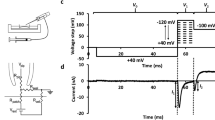Abstract
Muscle activity is associated with an increase in extracellular purines (ATP, ADP), which are involved in signalling mechanisms. The present study investigates the effect of purines on the function of Na,K-ATPase (Na,K-pump) in rat skeletal muscle. Na,K-ATPase activity was quantified by measuring the release of inorganic phosphate in the presence of ATP and variable Na+ concentrations. In membranes purified from glycolytic muscle fibres, purinergic stimulation increases V max and decreases the K m (higher Na+ affinity) of the Na,K-ATPase. Stimulatory effects were obtained using ATP, ADP, 2-methylthio-ADP and UPT, but not UDP and adenosine. The effect of ADP on V max can be inhibited by the non-specific P2Y receptor antagonists, suramin and PPADS. Moreover, the P2Y13 receptor antagonist MRS 2211 strongly inhibited the response to ADP, whereas the specific P2Y1 receptor antagonist MRS 2500 had less effect. Based on results from these agonists and antagonists, we conclude that P2Y13 receptors mediate the main effects observed, that P2Y1 receptors are also involved and that some P2Y2/P2Y4 receptors also appear to be involved. Receptor antagonists had no effect on ADP-induced subunit (phospholemman and α1) phosphorylation and changes in K m (Na+ affinity). Thus, the stimulatory effects of purines are mediated by two independent mechanisms: P2Y receptor-mediated increase in Na,K-ATPase capacity (increased V max) and P2Y receptor-independent phosphorylation of Na,K-ATPase phospholemman and α1 subunits, which induce changes in ion affinity. These mechanisms may contribute to up-regulation of Na,K-ATPase during muscle activity.




Similar content being viewed by others
References
Abbrachio MP, Burnstock G, Boeynaems J-M, Barnard EA, Boyer JL, Kennedy C, Knight GE, Fumagalli M, Gachet C, Jacobsen KA, Weisman GA (2006) International Union of Pharmacology LVIII: update in P2Y G protein-coupled nucleotide receptors: from molecular mechanisms and pathophysiology to therapy. Pharmacol Rev 58:281–341
Broch-Lips M, Pedersen TH, Nielsen OB (2010) Effect of purinergic receptor activation on Na+–K+ pump activity, excitability, and function in depolarized skeletal muscle. Am J Physiol Cell Physiol 298:C1438–C1444
Cantiello HF (1997) Actin filaments stimulate the Na+-K+-ATPase. Am J Physiol 269:F639–F643
Feschenko MS, Sweadner KJ (1997) Phosphorylation of Na, K-ATPase by protein kinase C at Ser18 occurs in intact cells but does not result in direct inhibition of ATP hydrolysis. J Biol Chem 272:17726–17733
Forrester T, Lind AR (1969) Adenosine triphosphate in the venous effluent and its relationship to exercise. Fed Proc 28:1280–1283
Fumagalli M, Trincavalli L, Lecca D, Martini C, Ciana P, Abbracchio MP (2004) Cloning, pharmacological characterization and distribution of the rat G-protein coupled P2Y13 receptor. Biochem Pharmacol 68:113–124
Ingwersen MS, Kristensen M, Pilegaard H, Wojtascewski FPF, Richter EA, Juel C (2011) Na, K-ATPase activity in mouse muscle is regulated by AMPK and PGC-1α. J Membrane Biol 242:1–10
Juel C (2009) Na+-K+-ATPase in rat skeletal muscle: muscle fiber-specific differences in exercise-induced changes in ion affinity and maximal activity. Am J Physiol Regul Integr Comp Physiol 296:R125–R132
Kristensen M, Juel C (2010) Na+, K+-ATPase Na+ affinity in rat skeletal muscle fiber types. J Membrane Biol 234:35–45
Kügelgen IV (2008) Pharmacology of mammalian P2X- and P2Y-receptors. Biotrend Reviews no. 3/9
Lee K, Jung J, Kim M, Guidotti G (2001) Interaction of the α subunit of Na, K-ATPase with cofilin. Biochem J 353:377–385
Lifshitz Y, Lindzen M, Garty H, Karlish SJD (2006) Functional interactions of phospholemman (PLM)(FYYD1) with Na+, K+-ATPase. J Biol Chem 281:15790–15799
Mahaut-Smith MP, Ennion SJ, Rolf MG, Evans RJ (2003) ADP is not an agonist at P2X1 receptors: evidence for separate receptors stimulated by ATP and ADP in human platelets. Brit J Pharmacol 131:108–114
May C, Weigl L, Karel A, Hohenegger M (2006) Extracellular ATP activates ERK1/ERK2 via a metabotropic P2Y1 receptor in a Ca2+ independent manner in differentiated human skeletal muscle cells. Biochem Pharmacol 71:1497–1509
Mortensen SP, González-Alonso J, Nielsen JJ, Saltin B, Hellsten Y (2009) Muscle interstitial ATP and norepinephrine concentrations in the human leg during exercise and ATP infusion. J Appl Physiol 107:1757–1762
Tamiya S, Okafor MC, Delamera NA (2007) Purinergic agonists stimulate lens Na-K-ATPase-mediated transport via Src tyrosine kinase-dependent pathway. Am J Physiol Cell Physiol 293:C790–C796
Therien AG, Blostein R (2000) Mechanisms of sodium pump regulation. Am J Physiol Cell Physiol 279:C541–C566
Voss AA (2009) Extracellular ATP inhibits chloride channels in mature mammalian skeletal muscle by activating P2Y1 receptors. J Physiol 587:5739–5752
Wang X, Davaiah SP, Zhang W, Welti R (2006) Signaling function of phosphatidic acid. Prog Lipid Res 45:250–278
Webb TE, Henderson DJ, Roberts JA, Barnard EA (1998) Molecular cloning and characterization of the rat P2Y4 receptor. J Neurochem 71:1348–1357
Acknowledgment
This study was supported by The Lundbeck Foundation.
Conflict of interest
No conflict of interest.
Author information
Authors and Affiliations
Corresponding author
Rights and permissions
About this article
Cite this article
Walas, H., Juel, C. Purinergic activation of rat skeletal muscle membranes increases V max and Na+ affinity of the Na,K-ATPase and phosphorylates phospholemman and α1 subunits. Pflugers Arch - Eur J Physiol 463, 319–326 (2012). https://doi.org/10.1007/s00424-011-1050-2
Received:
Revised:
Accepted:
Published:
Issue Date:
DOI: https://doi.org/10.1007/s00424-011-1050-2




